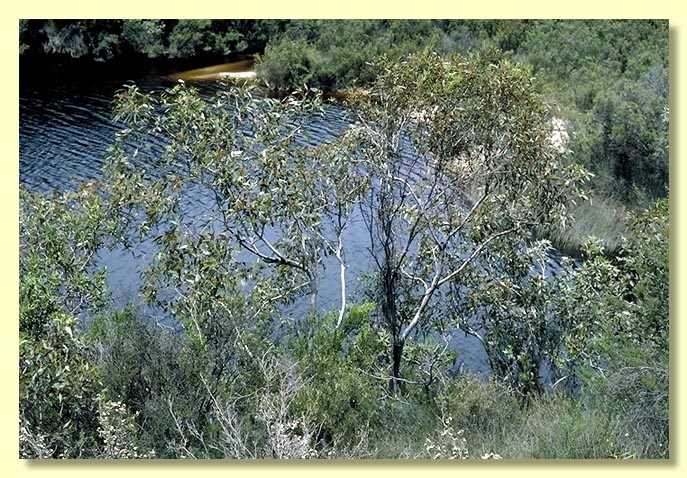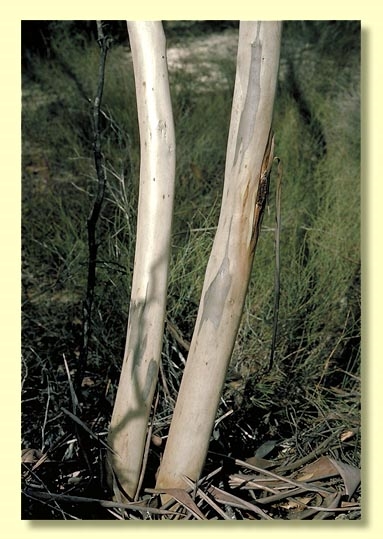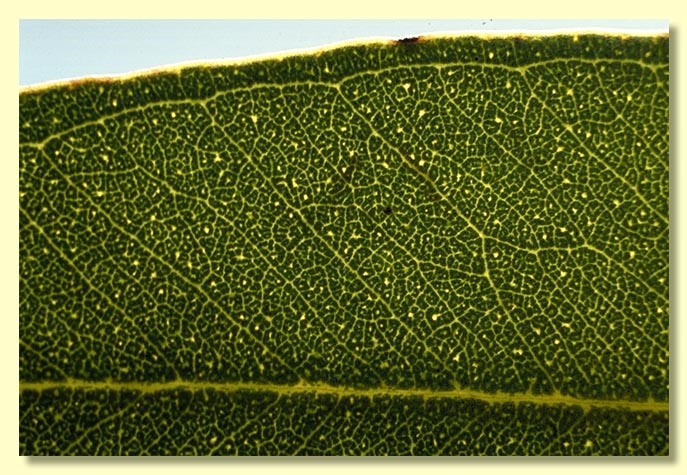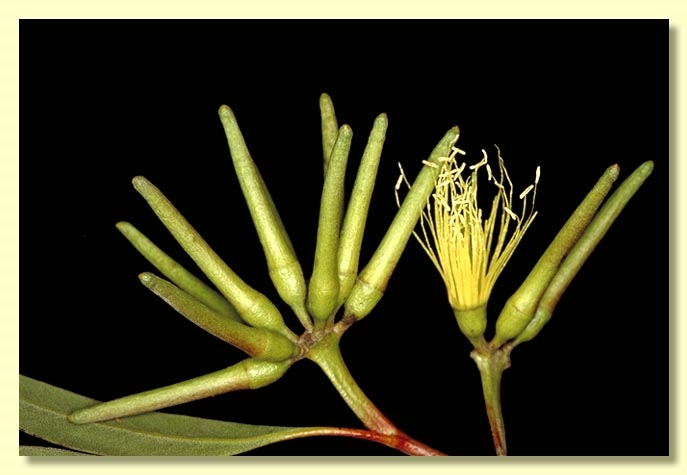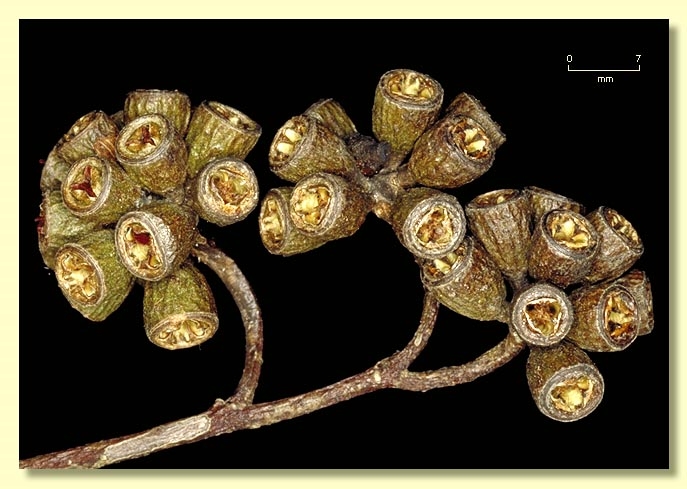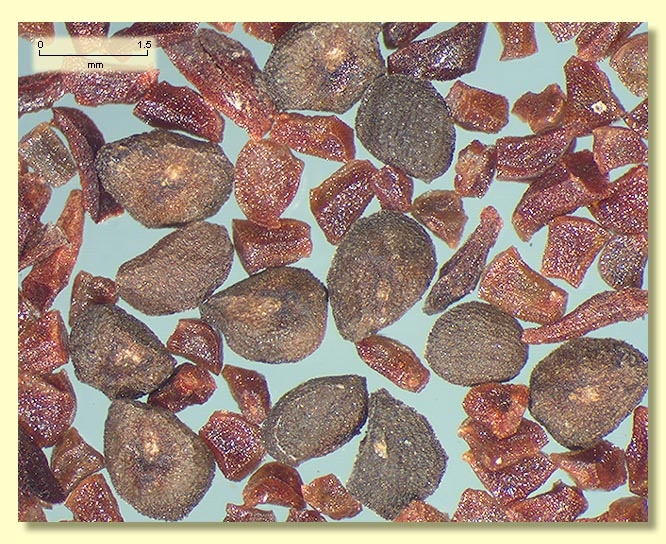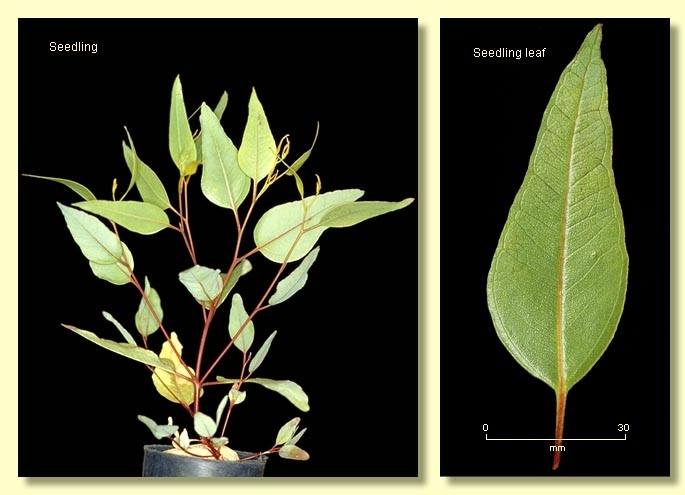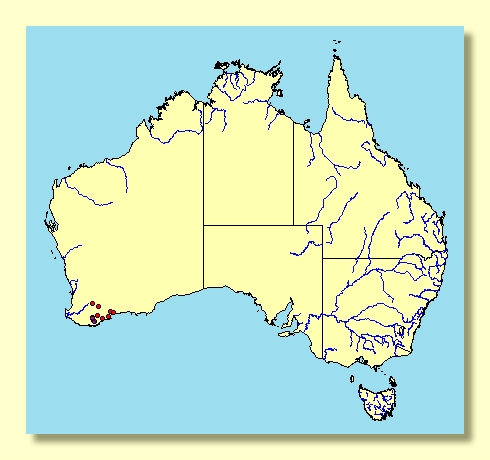Euclid - Online edition
Eucalyptus macrandra
Eucalyptus | Symphyomyrtus | Bisectae | Hadrotes | Cornutae
Eucalyptus occidentalis var. macrandra (F.Muell. ex Benth.) Maiden, J. W. Austral. Nat. Hist. Soc. 3: 187 (1911). "Forms a thicket of Marlock scrub on a slope of Gaalgagup Hill, Kalgan Plains [WA]." T: Stirling Ra., W.A., G.Maxwell; syn: K, MEL, NSW; Salt R., W.A., G.Maxwell; syn: K, MEL, NSW; Phillips Ra., W.A., G.Maxwell; syn: n.v.
Bark usually smooth throughout, grey over grey-brown. pink or salmon, rarely with a basal stocking of rough blackish bark.
Branchlets with oil glands in the pith.
Juvenile growth (coppice or field seedlings to 50 cm): stems rounded in cross-section; juvenile leaves always petiolate, alternate, ovate to elliptical, 4–7 cm long, 1.5–3 cm wide, glossy, green.
Adult leaves alternate, petioles 0.8–2 cm long; blade lanceolate, 5.5–12.2 cm long, (0.9)1–2.5(3.1) cm wide, base tapering to petiole, margin entire, apex finely pointed, concolorous, glossy, green to olive green, side-veins at an acute or wider angle to midrib, reticulation dense, intramarginal vein close to margin, oil glands obscure or intersectional.
Inflorescence axillary unbranched, peduncles broadly flattened, 0.6–2.6 cm long, buds (?9)13 to 31 or more, pedicellate (pedicels 0.1–0.4 cm long). Mature buds narrowly elongated (1.5–3.6 cm long, 0.2–0.7 cm wide), smooth, scar present (outer operculum lost early), inner operculum horn-shaped, straight, 4–5 times the length of the hypanthium, stamens erect, anthers narrowly oblong, versatile, dorsifixed, dehiscing by longitudinal slits, style long and straight, stigma blunt, locules 3 or 4, the each placenta with 4 vertical rows of ovules. Flowers pale yellow.
Fruit pedicellate (pedicels 0.1–0.4 cm long), elongated cupular to almost campanulate, 0.6–1 cm long, 0.7–1 cm wide, disc level or descending, valves 3 or 4, the tips free, at about rim level.
Seeds blackish to dark brown, 1–2 mm long, flattened-ovoid to slightly angular, dorsal surface shallowly reticulate, hilum ventral.
Cultivated seedlings (measured at node 10): cotyledons Y-shaped (bisected); stems rounded in cross-section; leaves always petiolate, opposite for ca 4 nodes, then alternate, ovate, 6–7.5 cm long, 2–3.5 cm wide, dull bluish green at lower nodes becoming glossy and green by node ca 8–9.
Flowering has been recorded in February, May, July, November and December.
Eucalyptus macrandra is commonly cultivated in southern Australia and makes an attractive garden specimen because of its large clusters on long straight slender buds and spectacular "balls" of yellow flowers.
A small tree or mallee endemic to Western Australia, east from Narrogin to Dragon Rock and south and south-east to the Stirling Range, Pallinup River and east to Hamersley River. The basal bark is thick, rough, black in larger trees but smooth in the mallees. The adult leaves are glossy, green to olive green.
Eucalyptus macrandra belongs in Eucalyptus subgenus Symphyomyrtus section Bisectae subsection Hadrotes because the cotyledons are coarsely bisected to bilobed, buds have an operculum scar, a long inner operculum and erect stamens, fruit are large, thick-rimmed and held rigidly. There are 10 species in subsection Hadrotes; however, only two of these, E. cornuta and E. macrandra, have oil glands in the pith of the branchlets and non-scabrid seedlings; together they form series Cornutae.
E. macrandra is distinguished from E. cornuta by the flat-topped fruit with free valve tips after seed is shed. E. cornuta has fruit with exserted valves that remain joined at the tips after seed-shed, like the more distantly related species of the E. lehmannii group. E. cornuta has buds in a cluster of up to 21 whereas E. macrandra can have up to 31 or more buds. The operculum of E. macrandra is longer and more slender than in E. cornuta.
A form of E. macrandra from between Kulin and Lake Grace and in the Dragon Rocks area was at one time regarded as being slightly different to E. macrandra, and plants were referred to the Brooker & Hopper manuscript name Eucalyptus olivacea. It is now believed that only one species exists, i.e. E. macrandra.

